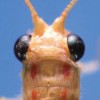 Few species of spiders can be considered truly social, but a greater number of species, particularly web-building spiders, live in close proximity to one another. One species which has become highly successful through a lifestyle of colonial aggregation is the orbweaver Cyrtophora citricola Forskål. This 6-page fact sheet was written by Lionel A. Stange, and published by the UF Department of Entomology and Nematology, October 2012.
Few species of spiders can be considered truly social, but a greater number of species, particularly web-building spiders, live in close proximity to one another. One species which has become highly successful through a lifestyle of colonial aggregation is the orbweaver Cyrtophora citricola Forskål. This 6-page fact sheet was written by Lionel A. Stange, and published by the UF Department of Entomology and Nematology, October 2012.
http://edis.ifas.ufl.edu/in966
Tag: Lionel A. Stange
Green lacewings (of Florida) Neuroptera: Chrysopidae (EENY534/IN965)
 The Chrysopidae are one of the largest and economically most important families of the Neuroptera. There are about 1,300 currently recognized species included in about 87 genera and three subfamilies (Brooks and Bernard 1990) in the world. In Florida, there are 22 species in 9 genera, all placed in the subfamily Chrysopinae (Penny et al. 1997). The larvae are voracious predators of small, comparatively soft-bodied arthropods such as aphids, scale insects, whiteflies, thrips, insect eggs, and other prey (Muma 1959; Canard et al. 1984). For this reason they are used widely in biological control. The adults are usually predators, but a few species only feed on pollen. This 4-page fact sheet includes Key to the Genera of Green Lacewings of Florida. Written by Lionel A. Stange, and published by the UF Department of Entomology and Nematology, November 2012.
The Chrysopidae are one of the largest and economically most important families of the Neuroptera. There are about 1,300 currently recognized species included in about 87 genera and three subfamilies (Brooks and Bernard 1990) in the world. In Florida, there are 22 species in 9 genera, all placed in the subfamily Chrysopinae (Penny et al. 1997). The larvae are voracious predators of small, comparatively soft-bodied arthropods such as aphids, scale insects, whiteflies, thrips, insect eggs, and other prey (Muma 1959; Canard et al. 1984). For this reason they are used widely in biological control. The adults are usually predators, but a few species only feed on pollen. This 4-page fact sheet includes Key to the Genera of Green Lacewings of Florida. Written by Lionel A. Stange, and published by the UF Department of Entomology and Nematology, November 2012.
http://edis.ifas.ufl.edu/in965
The Bumble Bees of Florida, Bombus spp. (EENY050/IN207)
 Bumble bees are easily recognized by the corbicula (pollen basket) on the hind tibiae in the females. They are beneficial insects that pollinate many native and ornamental plants. They can sting severely, so problem nests near human dwellings should be removed by experienced pest control operators. This 5-page fact sheet includes a key to the bumble bees in Florida. Written by Lionel A. Stange, and published by the UF Department of Entomology and Nematology, December 2011.
Bumble bees are easily recognized by the corbicula (pollen basket) on the hind tibiae in the females. They are beneficial insects that pollinate many native and ornamental plants. They can sting severely, so problem nests near human dwellings should be removed by experienced pest control operators. This 5-page fact sheet includes a key to the bumble bees in Florida. Written by Lionel A. Stange, and published by the UF Department of Entomology and Nematology, December 2011.
http://edis.ifas.ufl.edu/in207